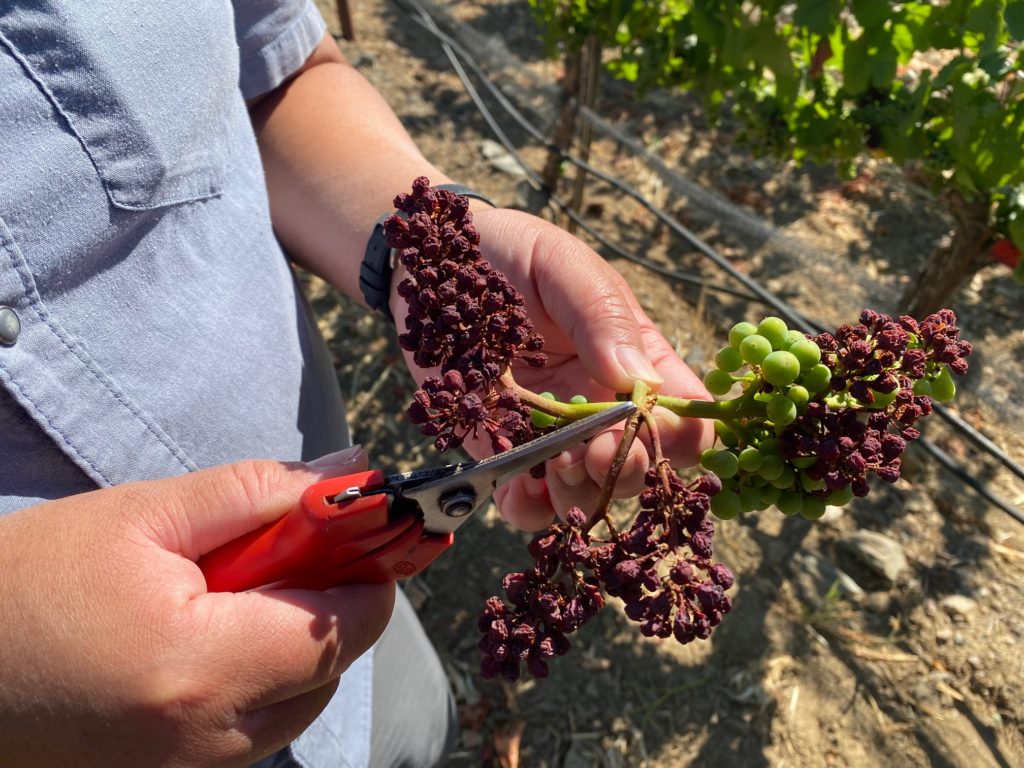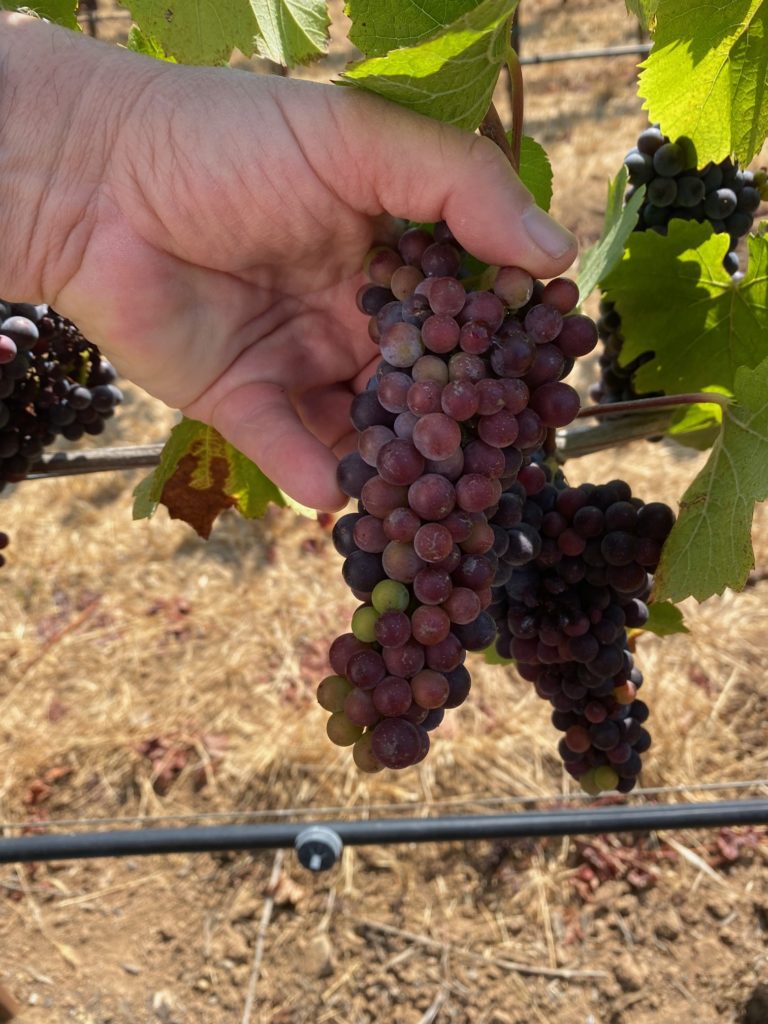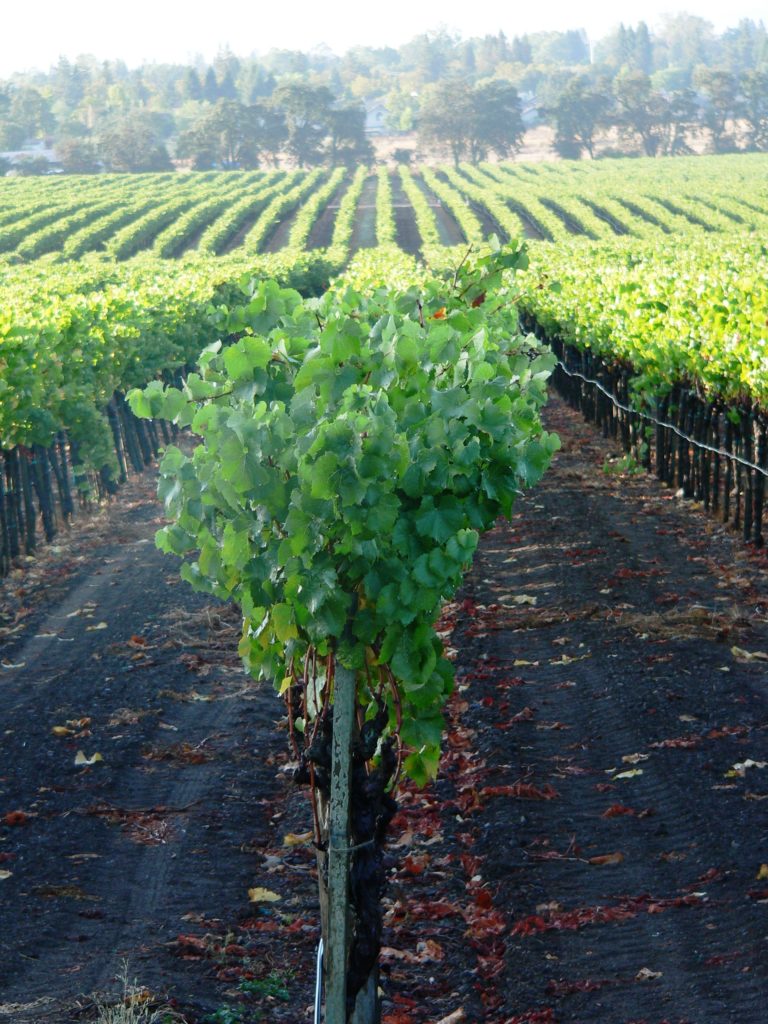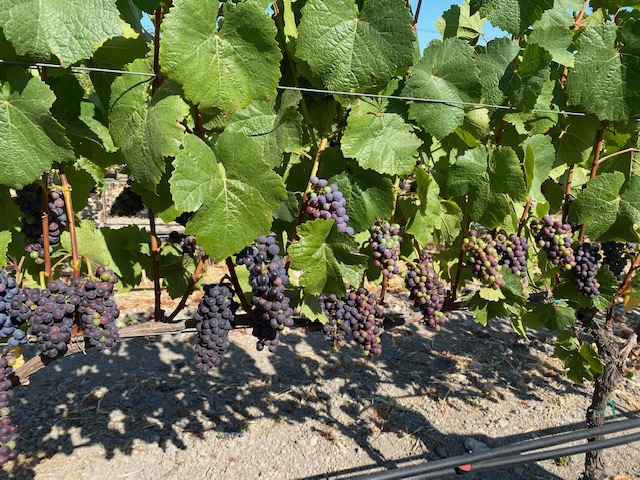What's cooking?
How early heat stress affects your vineyard
By Loni Lyttle and Mark Greenspan
Heat stress can do a lot of damage, and in many ways the earlier it hits, the worse it’s going to be. Here in Sonoma County, we got hit hard in June with a heat wave. We recorded cluster-zone air temperatures of at least 105° for four days straight in mid-June with over 22 hours of those high temperatures during that month. The surface temperature of exposed fruit can be up to 15°F above ambient depending on how much the grape is still able to transpire. Anything over 105°F (or 40°C) can cause irreversible damage.
What happens during high heat?
Intense sunlight and heat damage the crystalline structure the cuticle, a waxy covering on the epidermis that forms soon after flowering and stretches with the berry as it grows. This brings about the immediate visible damage you see after a heat event i.e. blisters and ruptured tissue. If the damage is less severe, grape berry surface may appear as glossy rather than matte. That cloudy bloom contains a lot of precursors necessary for the aromatic class of compounds known as thiols. In case you needed another reason to hate heat-stress.
Short-term effects of heat stress also include shriveling of fruit. This is usually evident only on sun-exposed berries, so one side of the cluster is usually damaged while the other remains intact. Varieties vary in their sensitivity to heat stress. Petit Sirah, for instance, shrivels rapidly and dramatically from heat stress.

More sinister though is the heat-induced denaturing of enzymes crucial for ripening. This means limited sugar loading, but also limited aromatic compounds, and limited phenolics. Weston et al. (2010) found that fruit exposed to 40°C heat at veraison and mid-ripening stages essentially stopped expanding or accumulating sugar.
This could also be a result of the vine abandoning fruit production in favor of maintaining its canopy. Excessive heat causes oxidative stress that damages the leaf’s photosynthetic machinery. Heat can inactivate Rubisco, the main enzyme involved in carbon fixation. This means limited sugar production as a whole in addition to the grape’s inability to import assimilates.
However, leaves may recover as long as heat exposure is not prolonged.
Fruit damaged from heat prior to veraison will exhibit berries that remain hard and green for an extended time. Even more common than that is fruit that remains pink, or bronze-colored rather than fully pigmented following veraison. Those berries may get darker over time but will never have the same anthocyanin content as undamaged berries.


So…heat stress stinks…what do I do about it?
Right now…you drop it. Sorry. This year we’ve seen a lot of variability, partly due to water stress early on but a lot of it can be blamed on this early heat event. You may be seeing a lot of pink out there, and the best you can do is eliminate it if you plan on making high quality wine. If it’s still pink and still flavorless, it’s not going to improve with more hang time. It will however shield your unaffected fruit from more heat damage. So, if you think another heat wave is on the horizon, you can leave it for that reason alone.
How do I avoid it in the future?
Shade cloth or leaving leaf cover
Shade cloth is certainly no secret. Block the sun and you get less burn. Ideally, you only need to shade the afternoon-sun side, although given row orientation or climate, covering both sides may be necessary. There’s a bit of a debate about what color maintains the coolest temperature. Oddly enough black seems to perform the best, most likely because it absorbs the entire spectrum of light. Other colors reflect light, meaning that any light that gets through will also bounce around inside the canopy thereby raising the temperature. That’s our working theory anyway.
With climate change, shade cloth is becoming increasingly desirable, or even necessary. This is unfortunate since every aspect of shade cloth is expensive from the material to the installation to taking it up and down every season. It’s also unsustainable, as it needs to be replaced every few years. Isn’t that just what the world needs? Acres of plastic? Oh, and it also impedes coverage of any spray treatments you apply. Awesome.
The best option is to leave extra leaf cover if you can. Tunneling (removing only interior leaves and laterals) does take time and money but calculate how much it’s going to cost to cover up the fruit you just exposed. Yet, given mildew pressure or scanty canopies, relying on leaf-cover may not be an option.

Trellis choice and row orientation
If you know heat and light exposure is going to be excessive, you can dial that in during vineyard planting. Common knowledge tells us that orienting your rows North-South helps shield fruit, but that logic is based on noon being the hottest time of day. It’s not. If we assume the hottest time of day is more like 3 o’clock, it’s better to orient your rows 30 to 40 degrees east of true North (or the other way around in the Southern hemisphere).
This still won’t do much to protect your vines if you insist on a tightly sandwiched VSP canopy. Leaving a slightly opened V-shaped canopy or a sprawl will protect your grapes much more effectively while allowing for better light-capture and better air flow as well.


Sprinklers
Sure, spraying water on your vines can cool them via evaporative cooling. I’m not sure who’s supposed to seriously adopt this method though. Here in California, we’re going through a bit of a dry spell (cough), so if you want to use this technique, I’d recommend using it extremely sparingly. Overhead sprinklers tend to overirrigate the vines, so you’re sacrificing quality to ensure vines are protected from heat-stress. They also can create a muddy mess and a disease risk after they’ve been run for a while. Cycling them on and off can reduce those negative consequences, but that is challenging to accomplish. Micro-sprinklers, will waste less water but can cause disease problems, especially in areas that struggle with downy mildew and Botrytis.
One thing I will say, if you want to spray a bunch of water all over your vines, please test your water quality first. Nothing like giving your poor vines a boron bath, a chloride bath…or a reclaimed water bath (which is not legal to do…ew!).
Appropriate leafing times
Early leafing right after fruit set allows the vine to acquire flavonols and xanthophylls. These compounds act as “sunscreen” in grapes prior to development of anthocyanins at veraison. If leafing is done early, fruit is first exposed during cooler springtime temperatures and will be better acclimated to hotter weather later in the season.
Can irrigation help?
Irrigating a couple days in advance of a heat event will better prepare the leaves to cool themselves but will do very little to protect exposed fruit.
Conclusion
The best thing to do is prevent heat stress from damaging your grapes via appropriate canopy management. Otherwise, happy green/pink fruit dropping to you. This is something we’re sure to see more of as the weather gets whackier.

Citations:
Greer, D. H., & Weston, C. (2010). Heat stress affects flowering, berry growth, sugar accumulation and photosynthesis of Vitis vinifera cv. Semillon grapevines grown in a controlled environment. Functional Plant Biology, 37(3), 206-214.
Keller, M. (2020). The science of grapevines. Academic press.

